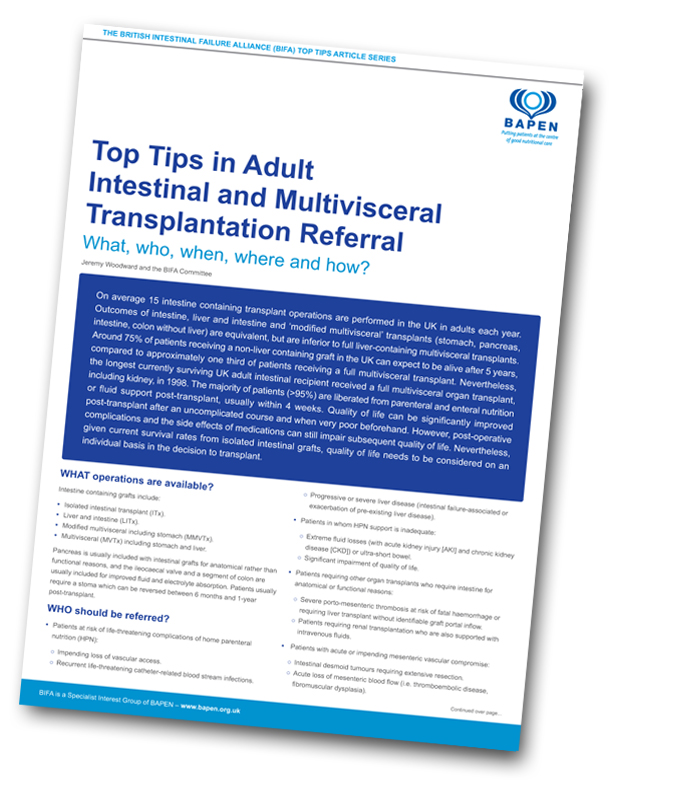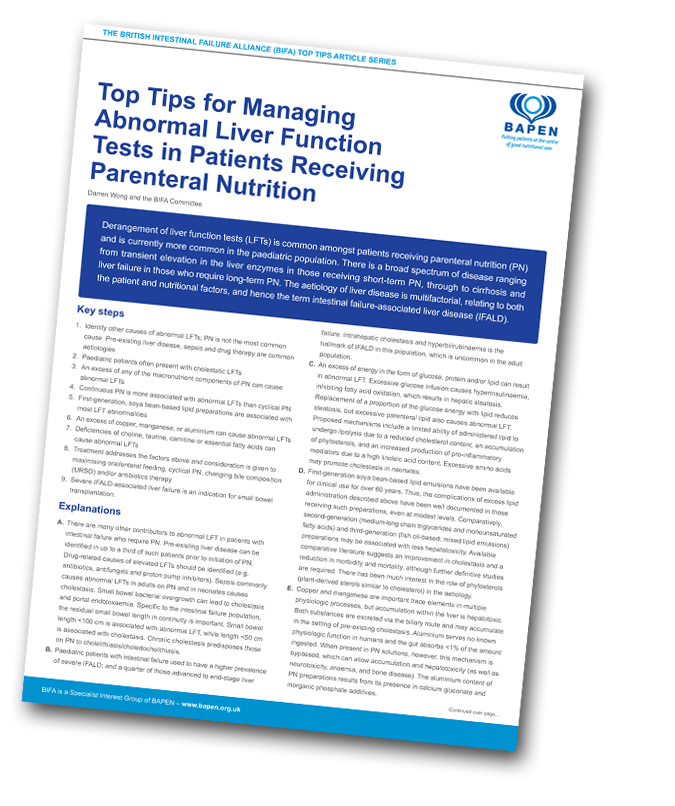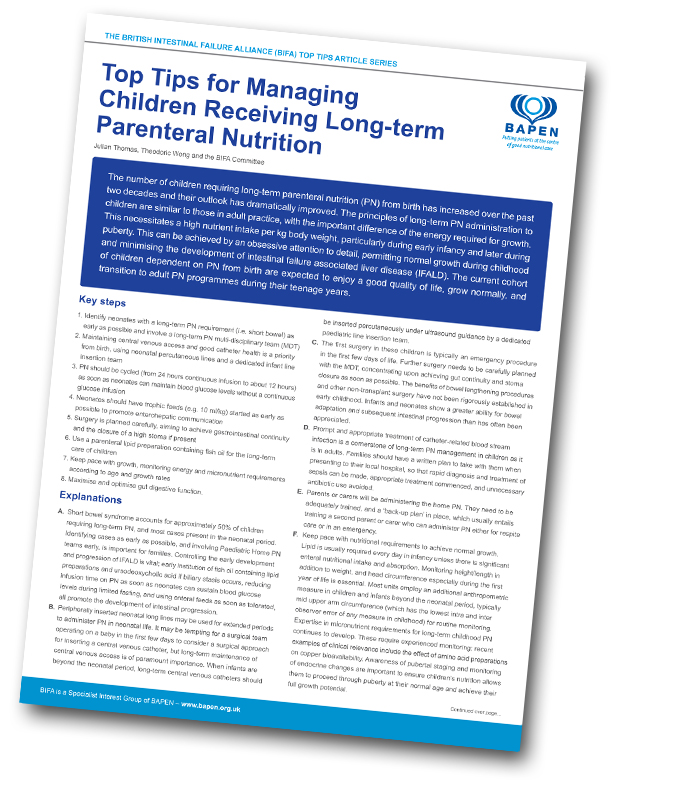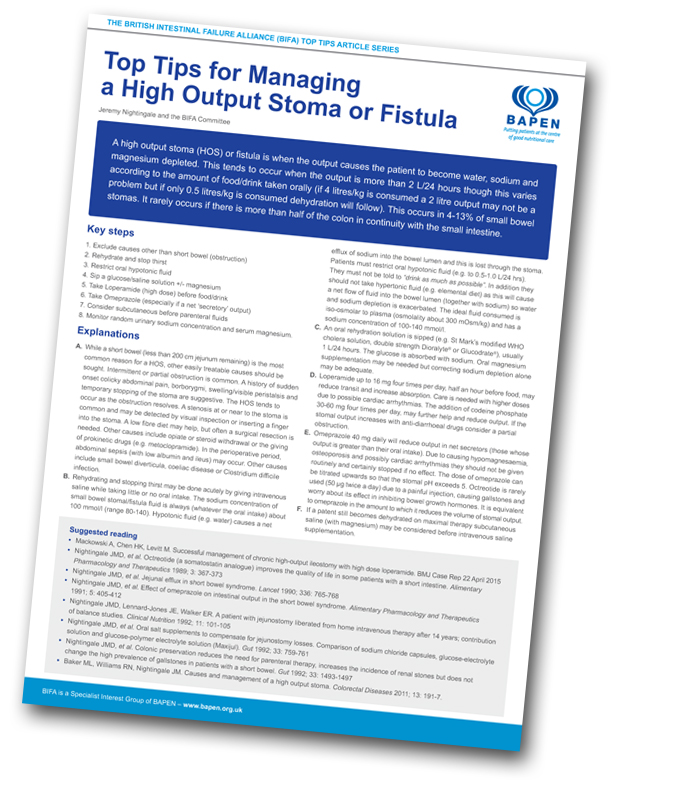The British Intestinal Failure Alliance (BIFA)
Top Tips Article Series
During 2018, through In Touch, BIFA – a Specialist Interest Group of BAPEN – will be sharing a series of articles. Utilising the breadth of experience of the BIFA Committee, each article will deliver top tips on a variety of topics, providing you with practical, helpful advice to utilise in your day-to-day practice.

Top Tips in Adult Intestinal and Multivisceral Transplantation Referral
What, who, when, where and how?
Jeremy Woodward, and the BIFA Committee

On average 15 intestine containing transplant operations are performed in the UK in adults each year. Outcomes of intestine, liver and intestine and ‘modified multivisceral’ transplants (stomach, pancreas, intestine, colon without liver) are equivalent, but are inferior to full liver-containing multivisceral transplants. Around 75% of patients receiving a non-liver containing graft in the UK can expect to be alive after 5 years, compared to approximately one third of patients receiving a full multivisceral transplant. Nevertheless, the longest currently surviving UK adult intestinal recipient received a full multivisceral organ transplant, including kidney, in 1998. The majority of patients (>95%) are liberated from parenteral and enteral nutrition or fluid support post-transplant, usually within 4 weeks. Quality of life can be significantly improved post-transplant after an uncomplicated course and when very poor beforehand. However, post-operative complications and the side effects of medications can still impair subsequent quality of life. Nevertheless, given current survival rates from isolated intestinal grafts, quality of life needs to be considered on an individual basis in the decision to transplant.
Click here to download the article.

Managing Abnormal Liver Function Tests in Patients Receiving Parenteral Nutrition
Darren Wong, and the BIFA Committee

Derangement of liver function tests (LFTs) is common amongst patients receiving parenteral nutrition (PN) and is currently more common in the paediatric population. There is a broad spectrum of disease ranging from transient elevation in the liver enzymes in those receiving short-term PN, through to cirrhosis and liver failure in those who require long-term PN. The aetiology of liver disease is multifactorial, relating to both the patient and nutritional factors, and hence the term intestinal failure-associated liver disease (IFALD).
Click here to download the article.

Managing Children Receiving Long-term Parenteral Nutrition
Julian Thomas, Theodoric Wong and the BIFA Committee

The number of children requiring long-term parenteral nutrition (PN) from birth has increased over the past two decades and their outlook has dramatically improved. The principles of long-term PN administration to children are similar to those in adult practice, with the important difference of the energy required for growth. This necessitates a high nutrient intake per kg body weight, particularly during early infancy and later during puberty. This can be achieved by an obsessive attention to detail, permitting normal growth during childhood and minimising the development of intestinal failure associated liver disease (IFALD). The current cohort of children dependent on PN from birth are expected to enjoy a good quality of life, grow normally, and transition to adult PN programmes during their teenage years.
Click here to download the article.

Managing a High Output Stoma or Fistula
Jeremy Nightingale and the BIFA Committee

A high output stoma (HOS) or fistula is when the output causes the patient to become water, sodium and magnesium depleted. This tends to occur when the output is more than 2 L/24 hours though this varies according to the amount of food/drink taken orally (if 4 litres/kg is consumed a 2 litre output may not be a problem but if only 0.5 litres/kg is consumed dehydration will follow). This occurs in 4-13% of small bowel stomas. It rarely occurs if there is more than half of the colon in continuity with the small intestine.
Click here to download the article.
